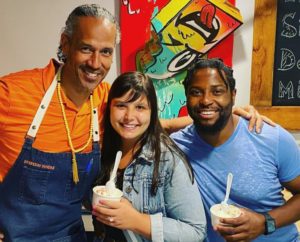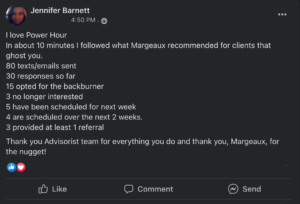

“Growth today is an investment for tomorrow.”
Hey Sunday Brewers!
Grab your favorite beverage and dive into this week’s edition to discover:
🔵 A secret to reducing health issues and prescription drug use by 33%?
🔵 Research says steer clear of these marketing words, phrases, & imagery
🔵 How a simple text/email sent to 80 people led to 9 appts and 3 referrals
But first, a little dose of kindness to start your week…
The First Sip

Walk into Everyday Sundae in the Petworth neighborhood of Washington, D.C. and you’re walking out with a cone…guaranteed.
The owner, Charles Foreman, has a knack for knowing when a visitor wants a treat but can’t afford one.
So he gives it to them for free.
“You know when they come in, you can see it,” Foreman explains. “It was naturally in me to (notice) some of the kids have it and some of the kids don’t have it. So I’m gonna sponsor them.”
As the store’s neighborhood continues to be gentrified, Foreman wants every single resident to know they’re welcome in his store.
“I just wanted to be a part of that change and show the kids that look like me and look like my son that it’s still a neighborhood for everybody,” he says.
As a graduate of the Culinary Institute of America, Foreman was a corporate chef for years.
Then the pandemic wiped his career out and left him wondering what he would do next.
A friend of his asked him: What would you do if you weren’t afraid?
That answer led to starting an ice cream shop.
The support from the community has been incredible – with random acts of kindness being a staple inside the shop.

One customer even noticed Foreman giving away a cone to a young boy who couldn’t afford it and returned with $100 in cash to buy future cones for other folks in the community.
“You can’t be mad and order ice cream. Everyone walks away with a smile,” Foreman says.
“If you can’t afford it, and I give you one for free, your smile’s even bigger, you know what I mean?”
1 Caffeinated Neurohack

A new research study finds spending time at a local park, community garden, or nearby hiking trail could (quite literally) be a lifesaver for people who live in urban areas.
Researchers found that urban residents who visit green spaces frequently are less dependent on drugs for:
- Depression
- Anxiety
- Insomnia
- High blood pressure
- Asthma
And here’s an interesting bit of info: It’s true regardless of the person’s gender, income, or level of education.
The research team says the frequency of visits to urban green spaces is the key. (Simply viewing from your house isn’t enough.)
Compared with less than one weekly visit, visiting 3X – 4X weekly was associated with 33% lower odds of using mental health meds, 36% lower odds of using blood pressure meds, and 26% lower odds of using asthma meds.
The equivalent figures for visiting at least 5X per week were 22%, 41%, and 24% lower, respectively.
You’re probably reading this thinking….yeah that makes sense…
But the real question is…why don’t we heed this advice more often?
For most advisors, I think it comes down to the illusion of productivity.
We tend to equate “sitting in front of a computer” with “productivity.”
(Even though much of the time we spend in the office is actually wasted time…scrolling through Facebook, cleaning out emails, browsing news sites, etc.)
However, what I’ve found over the years is that some of my most “productive” time actually occurs when I’m out in nature.
On a walk in the woods…
Sitting on a bench in a park…
These might not be considered “work” times, but they’re absolutely productive.
In addition to the physical health benefits alluded to in this study, time outside gives the brain the ability to process information from the day and store it away into long-term memory.
If you want to be a healthier advisor – mind, body, and soul – I’d encourage getting outside at least 3-4x per week.
☕ TL;DR: Spending time in nature can reduce prescription drug use by 33%
Marketing Psychology Quick Hit

Research by Capital Group says how retirement concepts are communicated to prospects plays a key role in whether or not they choose to work with an advisor.
“This research makes clear that both the language and imagery we use in retirement communications do matter in making an impact on people and inspiring them to take action,” head researcher Toni Brown says.
While there’s no one-size-fits-all approach to retirement communications, factors like age matter.
For example, Gen X investors find phrases like “saving smarter for retirement” appealing. They want to know their money is working for them to the greatest extent it can.
Boomers, however, find this language condescending and patronizing.
Millennials prefer phrases like “plan the retirement you deserve.”
Boomers tend to like imagery that portrays “enjoyment” and “transition.”
“Investors seem to want to know the pathway to retirement is doable, worth it, and in their control,” head researcher Tom Brown explains.
“When it comes to language, straightforward, factual statements about successful outcomes resonate most.”
Here are a few additional takeaways from the study:
👉 Outcome-oriented messages, such as “knowing that it’s possible to live the life I want in retirement,” are more effective than messages about getting started and learning
👉 “One of the most common mistakes” was the least preferred message, with 58% of respondents reporting that they did not associate it with feeling more confident
👉 People generally dislike images of people receiving healthcare in retirement and prefer portraits of retirement as a physically active time
More takeaways from the study can be found here.
☕ TL;DR: Research says steer clear of these marketing words, phrases, & imagery
What’s New in SHIFT Nation?

Want to find out which script she used?
Click the post above and read the comments!
Weekly Industry Catch-Up

🔹 January numbers. Retail sales jumped 3% in January, despite wholesale prices increasing by 0.7%. Economists are still fearful a full-blown recession is on the way.
🔹 Gen Z is focused. Contrary to popular belief, this new study shows America’s youngest working generation (Gen Z) is doing an “extraordinary” job saving for retirement.
Over 30% of this ‘post-Millennial’ generation is prioritizing retirement savings, with median savings hovering around $33,000.
That might not sound like much, but for 18-25 year-olds with 40+ years to retirement, it’s a great start. For perspective, the media retirement savings for millennials is just $50,000.
🔹 Bitcoin rebound. Bitcoin continues its 2023 rally (up 46% YTD as of writing). This despite increased crackdowns and a tougher regulatory stance from the U.S. government. Experts say lots of money is moving from altcoins to Bitcoin as investors suddenly become more bullish.
Be Well,
Jeremiah D. Desmarais
CEO, Advisorist
#1 in ROI-Driven Training for Advisors




